Table of Contents
Volcanoes
A volcano is the most striking evidence of a hot interior. There are about 250 active volcanoes at present, and about as many more that have been active in historic times. The cone shape of a volcano is due to its gradual building up by the ejection of material from the center hole, the volcanic vent. The hot lava flows outwards and downwards; or if shot into the air, it falls in a shower of fragments, forming volcanic ash, tuff, breccia, or agglomerate (ash being the finest stuff, and the rest of increasing size in the order given). Thus a conical mountain peak is built up, with a cup- shaped hollow, the crater, at the top.
When a volcano becomes inactive, the lava in the crater and vent solidifies. Sometimes activity is renewed, and the lava may burst out somewhere on the slope and build up a second cone.
Eruptions may be somewhat quiet, like those of Kilauea, Hawaii Islands, or violently explosive. The eruption of Krakotoa, in 1885, blew up a cubic mile of shattered rock, forming a column of volcanic dust 17 miles high. This moved with the upper air current completely around the earth. Vast quantities of volcanic ash and dust have in this way spread over the earth’s surface.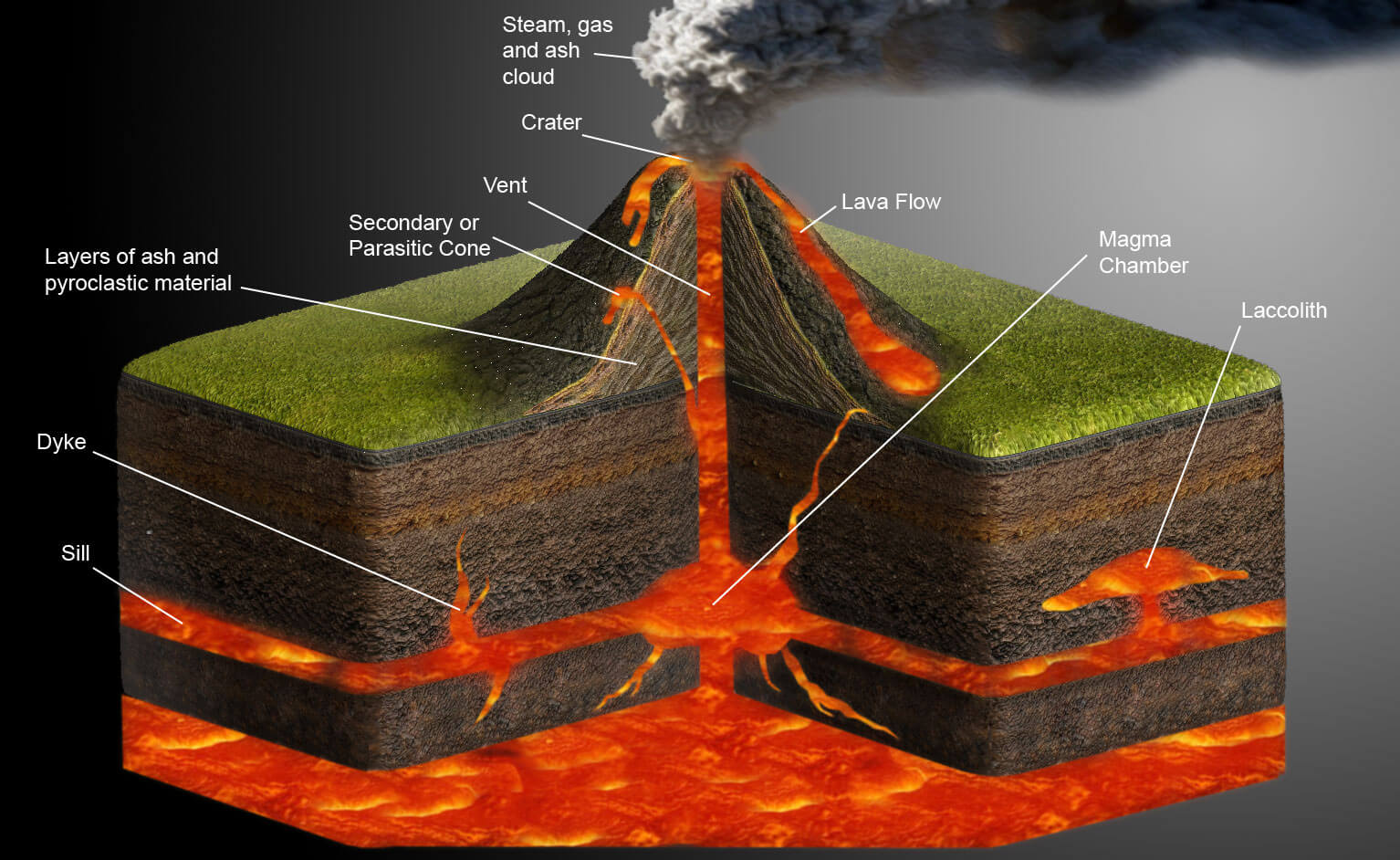
Large quantities of water come out with the lava, as great volumes of steam. It is believed that deep down in the hot interior, where the pressure is very great, the rock and water mix like alcohol and water, to form a solution. When the lava comes to the surface, the lower pressure allows the water to escape as steam, the expansion of which may blow the lava full of cavities; and when these are very small and abundant, the rock formed is lighter than water, and it is then called pumice stone.
Lava Flows
Lava from volcanoes sometimes flows many miles, covering large extents of country. Great lava-flows have taken place in past geological ages, the lava having poured out of cracks instead of volcanic vents. One in the western United States covered about 200,000 square miles of country to an average depth of 2000 feet. Another equally extensive flow in India is still deeper, about 4000 feet in places. The greatest flow of all is that which at one time covered the Lake Superior District, remains of which can be seen in the flat capping of dark rock on many of the hills and islands. Lava-flows through fissures have taken place in recent times in Iceland.
Volcanic Rocks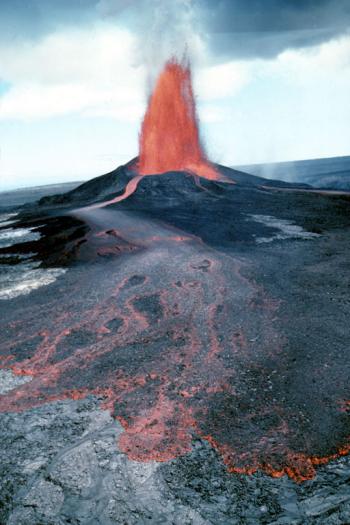
The majority of lava-flows are basic, that is they contain only about 40 to 50 per cent of silica; this may be contrasted with acid flows, which have 70 to 80 per cent of silica. Silica. the substance of quartz, is the common acid of minerals and rocks. Substances like lime, magnesia, potash, and soda are called bases. A rock high in silica is said to be acid; one low in silica and high in bases is said to be basic. Basic rocks melt at lower temperatures than acid rocks; as a consequence, the basic lavas are more fluid and flow longer distances.
The top of a lava flow is wrinkled, broken, and covered more or less with fragments, giving it the appearance called scoriaceous, very much like that of slag. This distinguishes a surface lava flow from one that has forced its way between strata, or through any break in rock, and has afterwards been exposed by erosion.
Lava sometimes flows from vents under the ocean. The peculiar structure called pillow lava or ellipsoidal basalt is supposed to have originated in this way. Basic lavas form dark colored rocks called basalt or trap. The light colored acid lavas are called rhyolite.
Rock Magma
The molten rock material in the interior of the earth is called rock magma. The water that is believed to be dissolved in this magma is called magmatic water; it has played a very important part in the making of veins, metamorphic rocks, and some other rock structures.
Geysers

Geysers and hot springs are further evidence of heat in the interior of the earth. Geysers are hot springs that burst up into fountains periodically. The flow of hot water and the escape of steam, continuing for a great many years, can be explained only by the presence of a deep-down mass of hot rock or rock magma. In the Valley of Ten Thousand Smokes, in Alaska, steam comes out at such high temperatures that a stick held in it bursts into flame when moved out into the air.
The water of geysers and hot springs deposits sometimes silica and sometimes carbonate of lime as a white incrustation, often colored by low forms of plant life (algae), which are able to withstand the high temperatures. Other minerals, such as pyrite and sulphur, are also deposited, and even gold has been found in the siliceous deposit of hot springs. This has a bearing on the origin of mineral veins some of which may have been formed by a process like this.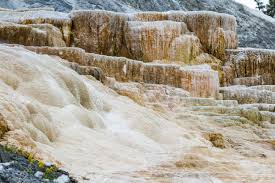
Rock intrusions
By flowing into breaks and between strata, the melted rock has formed masses of rock by comparatively slow cooling, allowing time for growth of crystals. The deeper the original position of the mass, the slower the cooling, and therefore the larger the crystals. The rate of growth of crystals, and therefore their size, has also been influenced by the presence of solvents, such as water, hydrofluoric acid, etc., that have kept the mass from becoming solid too quickly. The heat of the intruding rock causes changes in the rock with which it is in contact. Dikes, sills, laccoliths, volcanic necks, and stocks, are some of the forms taken by these intrusions among the rocks.
Dikes
Dikes are igneous rocks (igneous means produced by the action of fire) formed by the cooling of the rock magma in fissures. They vary in width from a fraction of an inch to many feet, and vary in length from a few feet to miles. They are sometimes branched; some are straight, and others curved or crooked. Dikes may dip at any angle; but in stratified rocks, an intrusive rock is not called a dike unless it cuts across the strata. Intrusions between the strata are called sheets or sills. The walls of a dike are often nearly parallel. Faster weathering of the other rock leaves the dike standing out as a ridge. When the dike has weathered faster, a ditch-like hollow may result. The faster cooling of the part of the dike in contact with the wall allows less time for growth of crystals, and a finer grained structure is the result, almost always noticeable in the broader dikes.
Basic dikes, such as those of diabase, are very conspicuous in granite and other light-colored rocks. On the other hand, granite and other acid dikes often show up as light-colored bands in the darker rocks. (Fig. 118).
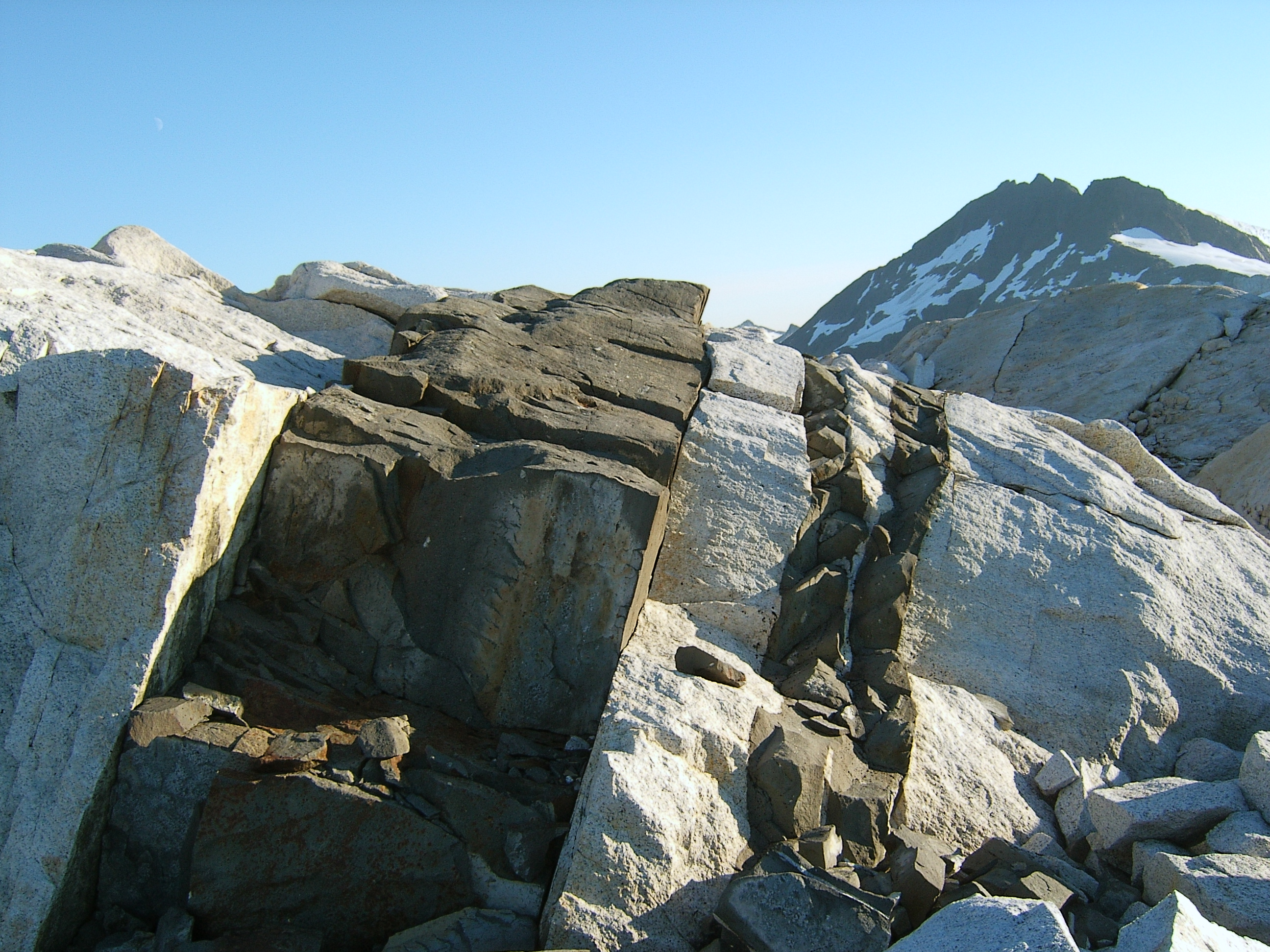
Sills
Sills are comparatively thin sheets of rock, which have been formed by the intrusion of the magma between the layers of sedimentary or metamorphic rocks, or even across such layers, provided the position of the sheet is near the horizontal. Sills may also break through unstratified rocks; they are usually composed of the basic rocks, and may be miles in extent. A basic magma flows more freely than acid magma. The silver ores of the Cobalt district are associated with diabase sills.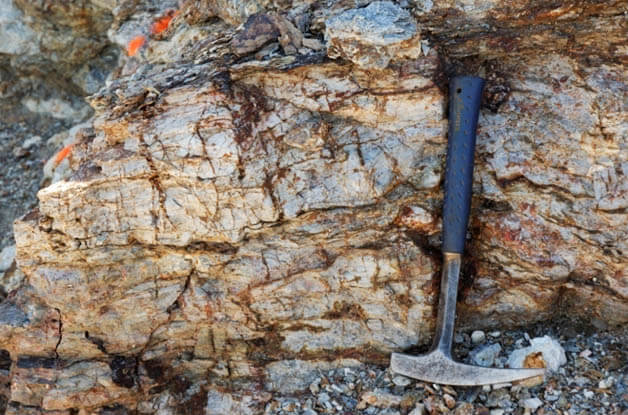
Laccoliths
When an intrusive sheet has been pushed in between the strata with force enough to arch up the overlying beds, a large, dome- shaped space has been filled, and a laccolith has been formed, which, by erosion, may have been brought to view at the surface; they are sometimes of the dimensions of mountains. The nickel ores of the Sudbury area are found around the edge of a great basic laccolith, which, however, is not dome- shaped, but like a basin or boat.
Volcanic Necks
Volcanic necks are the rock-filling of the vents of ancient volcanoes. By erosion, the greater part of the cone may have disappeared; and if the neck or plug has resisted better, it is left standing out as a rounded rocky mass. Other volcanic necks may have weathered faster than surrounding rocks, leaving rounded depressions. The South African diamond fields are volcanic necks, filled with weathered olivine rock, etc.
Stocks
A stock, or boss, is an irregular, somewhat round, mass of igneous rock, which has probably formed at great depths by the rock magma pushing up the overlying rock, or by melting its way upward; the mass has then slowly crystallized.
If composed of a resistant rock, like granite, the stock may be left standing up as a rounded hill, when erosion has carried away the surrounding rock.
Batholiths
When such rock masses (stocks) are very large, extending sometimes hundreds of miles, they are called batholiths, meaning “deep rocks,” referring to the idea that they are the exposed tops of great masses of deep-lying rocks. Granite batholiths underlie large parts of Canada, particularly in British Columbia, Manitoba, Ontario, and Quebec.
